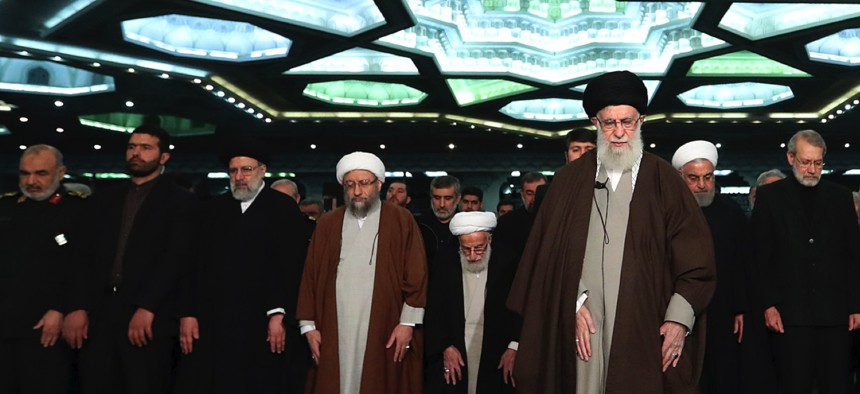
In this photo released by the official website of the office of the Iranian supreme leader, Supreme Leader Ayatollah Ali Khamenei, center, leads the Friday prayers at Imam Khomeini Grand Mosque in Tehran, Iran, Friday, Jan. 17, 2020. Office of the Iranian Supreme Leader via AP
Trump’s Iran Strategy Isn’t Working as Well as He Thinks
The killing of Qassem Soleimani upended expectations in useful ways, but the U.S. isn’t in a position to capitalize on the turmoil.
The killing of the Iranian general Qassem Soleimani by drone strike in early January, along with Tehran’s notably limited retaliation, has given President Donald Trump reason to believe his strategy toward Iran is working. Widely condemned at first as a rash over-escalation, the Soleimani strike instead disrupted Iran’s expectations in a way that created both risks and opportunities.
Trump and his team deserve enormous credit for reversing Barack Obama’s tendency to focus exclusively on the danger of Iranian retaliation against the United States and its allies—an attitude that made the Obama administration reluctant to punish Iran for its misconduct in the region. That hesitation gave Iran wide latitude for troublemaking. Trump sent a different message. As General Kenneth F. McKenzie, the leader of U.S. Central Command, noted at an International Institute for Strategic Studies event last fall, “Iran has escalation options, but we own the top steps of the escalation ladder.”
Yet one swift change in momentum in the administration’s favor does not mean the president’s entire strategy is succeeding. In fact, it’s not working as well as Trump and his aides seem to think.
Soleimani’s allies and patrons are still in charge of Iran. Missiles continue to be fired at the U.S. embassy in Baghdad, signaling a return to damaging—but deniable—behavior by Iran and its allies. Iran is still making appreciable progress toward nuclear weapons, and the time it would need to produce 25 kilograms of nuclear fuel has unquestionably shrunk since the United States withdrew from the nuclear deal that Obama, the European Union, and other partners negotiated with Tehran.
Related: On Iran, It's Time to Return to Containment
Related: Iran Is Expanding Its Online Disinformation Operations
Related: How Quickly Could Iran Get a Nuclear Bomb?
Trump’s administration is unquestionably right that Iran should be prevented from getting nuclear weapons, that it works to destabilize every other government in the Middle East, and that it’s a danger to neutral shipping, a threat to Israel, and a violator of the human rights of its own citizens. In a 2018 speechdelivered at the Heritage Foundation, Secretary of State Mike Pompeo laid out a series of important conditions—the withdrawal of Iranian forces from Syria, an end to Iran’s ballistic-missile and nuclear-weapons programs, and many other things—for easing American sanctions on Iran.
The administration’s Iran strategy has six elements: First, Trump withdrew from the nuclear agreement because it did not constrain Iran’s ballistic-missile programs and had a termination date. Second, the United States imposed “maximum pressure” sanctions, strangling Iran’s economy to drive the government into negotiating a deal with greater restrictions on Iranian nuclear-weapons programs and other malign behavior. Third, the administration wants to prevent Europe from acquiescing in Iranian resumption of activities that had been constrained by the nuclear agreement. Fourth, the United States killed Soleimani, the powerful commander who had been responsible for attacks on Americans, and the architect of Iran’s policies to destabilize Middle East governments. Fifth, Trump and his team now seek to manage any potential escalation in the aftermath of the Soleimani attack. Finally, they hope to amplify protests within Iran to further delegitimize the Iranian regime.
So far, the current American administration has not been trigger-happy. The United States didn’t respond when Houthi fighters in Yemen fired Iranian-supplied missiles at Saudi Arabian civilian airports. Nor did they respond to Iranian attacks on neutral shipping in the Persian Gulf, or to Iran’s drone attack on Aramco facilities in Saudi Arabia. One reason the Soleimani strike was so surprising (despite having been approved seven months earlier) was that the administration had not retaliated for those previous assaults. American allies in the region and beyond were eager to have the United States “reestablish deterrence”—by which they meant show Iran that military attacks have military consequences.
The most alarmed reactions to the strike on Soleimani have not been borne out. The U.S. administration did a good job conveying messages to the Iranian government during the tense days immediately following the strike—and it evidently resulted in the Iranian regime’s directly stating it would not retaliate beyond the initial missile strikes on Iraqi bases where American forces are stationed. Any rallying around the Iranian flag was quickly overtaken by public outrage after the government shot down a civilian airliner, then attempted unsuccessfully to cover up its own culpability.
Nevertheless, the United States does not appear to be in a position to capitalize on the aftermath of the Soleimani strike. Iranians are furious with their government, but their government continues to be willing to incarcerate and torture large numbers of them. And the theory of how disaffection within the Iranian public—over the downing of the airliner and so much more—leads to the overthrow of the current regime remains opaque at best.
Meanwhile, signs of trouble abound in the surrounding region. After the Soleimani attack, Iraq may revoke our right to keep troops in their country, or severely restrict our uses of those forces, in ways that prevent their effectiveness either in fighting ISIS or containing Iranian behavior.
American allies around the Persian Gulf are fuming that the U.S. didn’t respond more forcefully to the attacks on Saudi Arabia and to neutral shipping, thereby raising questions about the value of our security guarantee. The administration’s preferred way to reassure these allies is to deploy military forces—14,000 more U.S. personnel have been sent to the Middle East since Trump was elected. But this approach is less meaningful as military capability matters far less than the political willingness to use it on behalf of allies. Because the United States is seen as unreliable, what’s necessary to reassure these allies is getting more expensive.
In another worrisome sign, the only countries willing to join a U.S.-led maritime force in the Gulf have been Albania, Australia, Bahrain, Saudi Arabia, the United Arab Emirates, and the United Kingdom. As one indicator of the concern about American policy, more U.S. allies have committed forces to a competing French-led European Union coalition.
The EU and the Trump administration are working at cross purposes in other ways. The EU, which preferred Obama’s approach, went so far as to build a payment system that would allow global companies to circumvent dollar sanctions on Iran. That mechanism lies unused because businesses are unwilling to risk U.S. Treasury sanctions in order to do business with companies in Iran, whose economy is half the size of Maryland’s. Nevertheless, for the EU—led by Britain, France, and Germany, three of our closest friends—to create a mechanism to circumvent U.S. policy is truly startling.
European countries have also raised the possibility of reimposing economic sanctions on Iran, as the United States did. But they are doing so to get Iran back into compliance with the Obama-led nuclear agreement, not to force Iran to make the broader concessions that the Trump administration wants.
In short, the administration’s policies have created some potentially useful turmoil with respect to Iran. But they do not appear to be advancing toward their objectives—and the United States is incurring significant reputational, military, and security costs in the process.
NEXT STORY: ISIS Is No Reason to Stay in Iraq




